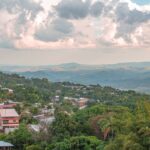We all count on ecosystems — and the natural resources we extract from them — to provide humanity with what it needs to survive and thrive. From fertile soils to forests and raw materials underground, nature appears to be an endless fountain furnishing all that we eat, drink, wear, live in, buy and rely on for fuel.
Yet climate change, declining biodiversity, ecosystem destruction, land degradation and pollution threaten our global life support system, putting whole societies at risk. After 20 years of working in international nature conservation, I have concluded that long-term investment in holistic landscape management and restoration is the key to future-proofing our planet while creating sustainable livelihoods for communities.
“Holistic” is the key word here. There is no point in restoring one tributary of a polluted river without tackling the whole basin — the problem will only resurface, and the investment will be rendered futile. From a risk perspective, it’s essential to consider the entire living system rather than pulling it apart.
That’s why we must create a global “industry” for landscape restoration. This industry is the most effective vehicle to protect our planet’s vital ecological infrastructure. Fortunately, the economic case for such a model is becoming crystal clear.
Investing in long-term results
Restoring a landscape takes at least a generation. While you can’t put a price on survival, the evidence shows it is a worthwhile investment. Economic studies reveal that the financial benefits of restoration are, on average, eight to ten times greater than initial investment costs across all types of ecosystems. As just one example, in Europe, the restoration of biodiversity-rich land is estimated to cost $167 billion, but benefits generated from this effort are valued at more than $2 trillion.
Businesses must be proactive with their investments. The climate and biodiversity crises will no doubt dominate the second half of this century, so we must be prepared. By funding landscape rehabilitation processes now, we will mitigate risks for investors, businesses and communities on the ground while saving money in the long run. A recent study published by the Food System Economics Commission makes this clear: They estimate that a shift toward more sustainable food systems could be worth more than $10 trillion annually.
In addition to being economically viable, landscape restoration is socially transformative for communities.
Read the full story here.
—-
The full story was written by Willem Ferwerda, CEO of 1000L partner Commonland. It originally posted on March 1, 2024, as part of Forbes EQ BrandVoice, a partnership spotlighting organizations championing representation, inclusion & systemic equity.


